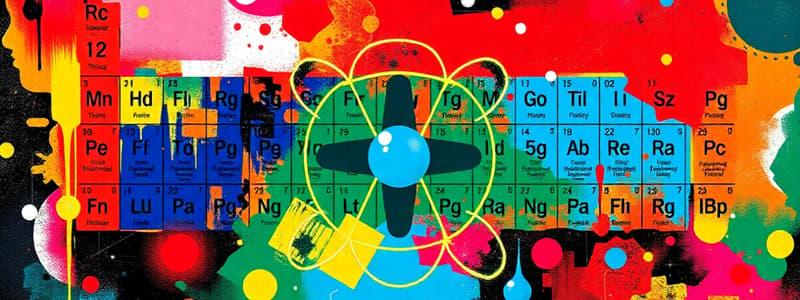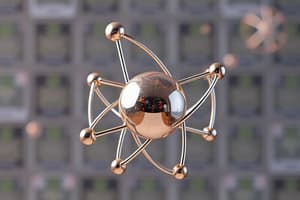Podcast
Questions and Answers
What characterizes a neutral atom?
What characterizes a neutral atom?
- It has the same number of protons and neutrons.
- It has different numbers of protons and electrons.
- It has the same number of protons and electrons. (correct)
- It has a net positive charge.
Which statement correctly describes an ion?
Which statement correctly describes an ion?
- It is electrically neutral.
- It can be formed from multiple atoms.
- It always has the same number of neutrons as protons.
- It has different numbers of protons and electrons. (correct)
How would you represent a lithium ion with a +1 charge?
How would you represent a lithium ion with a +1 charge?
- Li+1 (correct)
- Li-1
- Li0
- Li+2
Which of the following describes a negatively charged atom?
Which of the following describes a negatively charged atom?
How many total electrons does the Al+3 ion contain?
How many total electrons does the Al+3 ion contain?
If an atom has 4 protons and 5 electrons, what is its charge?
If an atom has 4 protons and 5 electrons, what is its charge?
What is the process called when an atom loses an electron?
What is the process called when an atom loses an electron?
Which of these isotopes of Lithium has the highest mass number?
Which of these isotopes of Lithium has the highest mass number?
What is the total number of neutrons in the isotope 7Li?
What is the total number of neutrons in the isotope 7Li?
Which of the following atoms would be represented as Ca +2?
Which of the following atoms would be represented as Ca +2?
What is the atomic number of an element represented by its protons count?
What is the atomic number of an element represented by its protons count?
Which positive ion has 25 total electrons after losing electrons?
Which positive ion has 25 total electrons after losing electrons?
In the notation 12C, what does the number 6 represent?
In the notation 12C, what does the number 6 represent?
What describes isotopes?
What describes isotopes?
Which positive ion has lost 5 electrons according to common understanding?
Which positive ion has lost 5 electrons according to common understanding?
What is the definition of isotopes?
What is the definition of isotopes?
How many neutrons are present in a Sodium atom, given it has an atomic number of 11 and a mass number of 23?
How many neutrons are present in a Sodium atom, given it has an atomic number of 11 and a mass number of 23?
In a neutral atom, how does the number of protons compare to the number of electrons?
In a neutral atom, how does the number of protons compare to the number of electrons?
What is the mass number of an element with 8 protons and 8 neutrons?
What is the mass number of an element with 8 protons and 8 neutrons?
If an atom of Carbon has 6 protons, how many electrons does it have, if it is neutral?
If an atom of Carbon has 6 protons, how many electrons does it have, if it is neutral?
What governs the maximum number of electrons that can occupy the second energy level in an atom?
What governs the maximum number of electrons that can occupy the second energy level in an atom?
How can you find the number of neutrons in an atom using the periodic table?
How can you find the number of neutrons in an atom using the periodic table?
In the Bohr model of an atom, how many electrons can the first energy level hold?
In the Bohr model of an atom, how many electrons can the first energy level hold?
An atom has 10 protons and 12 neutrons. What is its mass number?
An atom has 10 protons and 12 neutrons. What is its mass number?
What subatomic particle carries a positive charge?
What subatomic particle carries a positive charge?
Which statement is true regarding the mass of subatomic particles?
Which statement is true regarding the mass of subatomic particles?
In a neutral atom, which of the following conditions holds true?
In a neutral atom, which of the following conditions holds true?
How is the atomic number defined?
How is the atomic number defined?
What determines the identity of an atom?
What determines the identity of an atom?
Which of the following correctly describes neutrons?
Which of the following correctly describes neutrons?
How can you find the number of neutrons in an atom?
How can you find the number of neutrons in an atom?
Where are electrons located in an atom?
Where are electrons located in an atom?
Flashcards
What is an atom?
What is an atom?
The smallest unit of matter, composed of protons, neutrons, and electrons.
What are protons?
What are protons?
Positively charged particles found in the atom's nucleus.
What are neutrons?
What are neutrons?
Neutral particles found in the atom's nucleus.
What are electrons?
What are electrons?
Signup and view all the flashcards
What is an atom's atomic number?
What is an atom's atomic number?
Signup and view all the flashcards
What is an atom's mass number?
What is an atom's mass number?
Signup and view all the flashcards
What are isotopes?
What are isotopes?
Signup and view all the flashcards
What is an ion?
What is an ion?
Signup and view all the flashcards
Atomic Number
Atomic Number
Signup and view all the flashcards
Mass Number
Mass Number
Signup and view all the flashcards
Proton
Proton
Signup and view all the flashcards
Electron
Electron
Signup and view all the flashcards
Neutron
Neutron
Signup and view all the flashcards
Bohr Model
Bohr Model
Signup and view all the flashcards
Ion
Ion
Signup and view all the flashcards
Ionization
Ionization
Signup and view all the flashcards
What are cations?
What are cations?
Signup and view all the flashcards
What are anions?
What are anions?
Signup and view all the flashcards
What is the atomic number?
What is the atomic number?
Signup and view all the flashcards
What is the mass number?
What is the mass number?
Signup and view all the flashcards
What is ionization?
What is ionization?
Signup and view all the flashcards
What is the charge of an ion?
What is the charge of an ion?
Signup and view all the flashcards
What is the hyphen notation for Deuterium?
What is the hyphen notation for Deuterium?
Signup and view all the flashcards
What is the hyphen notation for 6Li?
What is the hyphen notation for 6Li?
Signup and view all the flashcards
What is the hyphen notation for 7Li?
What is the hyphen notation for 7Li?
Signup and view all the flashcards
What is the element and atomic/mass numbers of these isotopes: 12C, 13C, 14C?
What is the element and atomic/mass numbers of these isotopes: 12C, 13C, 14C?
Signup and view all the flashcards
How many protons and neutrons are in the first isotope (12C)?
How many protons and neutrons are in the first isotope (12C)?
Signup and view all the flashcards
Study Notes
Atomic Structure & Periodic Table
- Matter is anything that takes up space and has mass
- All matter is made of atoms
- Atoms are the building blocks of matter
- Atoms are too small to be seen
- A penny contains 2 x 1022 atoms
- Atoms have protons, neutrons, and electrons
Structure of the Atom
- An atom is the smallest unit of matter
- Atoms contain a nucleus made up of protons and neutrons
- Protons are positively charged particles
- Neutrons are neutral particles (have no charge)
- Electrons are negatively charged particles
- Protons and neutrons are much heavier than electrons
- Electrons are found in the electron cloud surrounding the nucleus
- Electrons are in constant motion
- Electrons are responsible for the atom’s reactions
Periodic Table Information
- Atomic Number is equal to the number of protons
- The number of protons determines the element
- In a neutral atom, the number of electrons is equal to the number of protons
- Mass Number = number of protons + number of neutrons
- Electron number = atomic number
Rules for electron arrangement
- 1st energy level holds up to 2 electrons
- 2nd energy level holds up to 8 electrons
- 3rd energy level holds up to 18 electrons
Ions
- Ions are atoms with a positive or negative charge
- Positive ions (cations) lose electrons
- Negative ions (anions) gain electrons
Isotopes
- Isotopes are atoms of the same element with different numbers of neutrons
- Isotopes have the same number of protons but different mass numbers
- Mass number = protons + neutrons
- Isotopes have the same atomic number
Studying That Suits You
Use AI to generate personalized quizzes and flashcards to suit your learning preferences.




